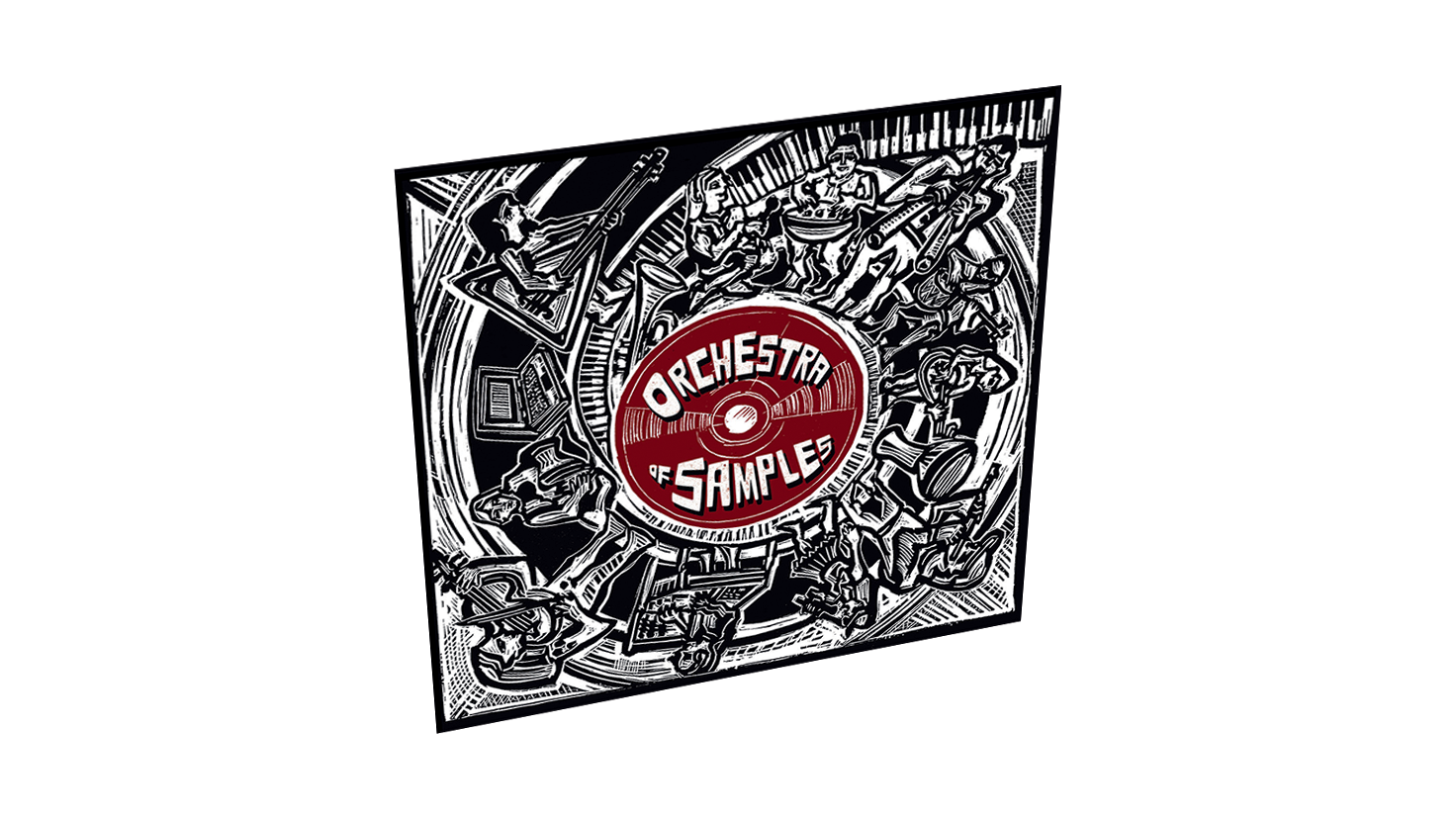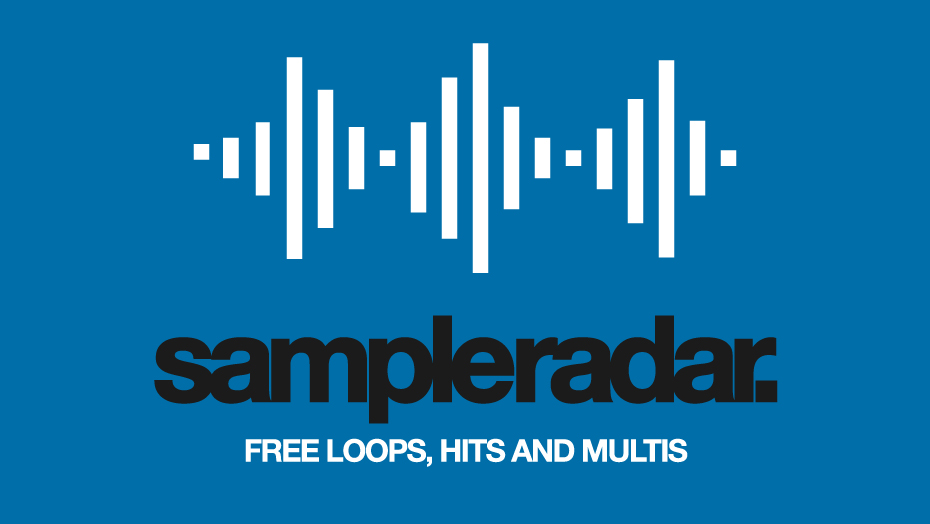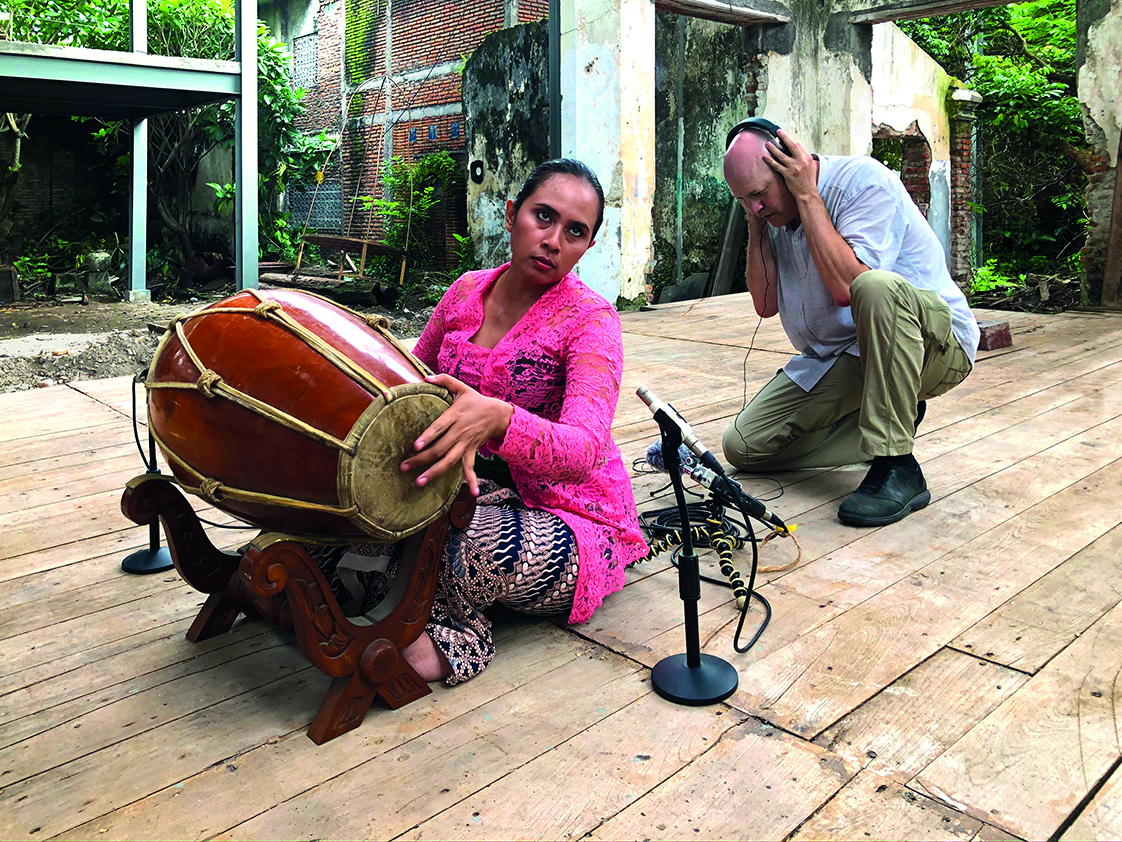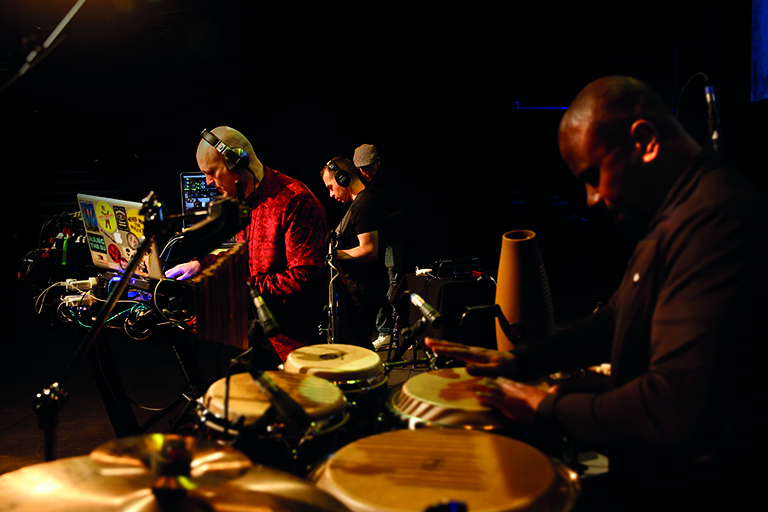Classic album - Addictive TV on Orchestra of Samples: "From top-end studios to field recordings, the album was literally recorded in hundreds of places"
On this groundbreaking album, audiovisual collective Addictive TV sourced and pieced together thousands of samples from across the globe

A cast of hundreds, providing thousands of hours of improvised music, recorded across every far-flung region of the world, over seven years. This was the start of Addictive TV’s Orchestra of Samples album.
This audio/visual collective made it their task to find, befriend and record musicians across the globe. Some in studios, rooftops, parks, hotel rooms, or even makeshift spaces on desert roads. The players improvised as they were filmed, largely soloing to tracks that didn’t exist yet, to feature alongside other artists that hadn’t yet been recruited either.
Some were famous (Grammy winners and members of Stereolab and Motörhead somehow getting swept up in it all). But many, with more invisible names, were playing instruments unique to them.
“Some of these instruments are in need of preservation. In some cases there are only a handful of musicians left playing them,” says founding member Graham Daniels, who, alongside manager Francoise Lamy and producer Stephen ‘Morf’ Hollands, maintain the project. Working with favours, arts grants, and sheer will, they began joining the musical dots, capturing the most beautiful and rare instruments and players for prosperity.
“It was about bringing these different types of instruments together and connecting cultures,” says Daniels. “At the start of creating a track you would never know who or what instruments would end up working together. It’s like doing a jigsaw puzzle without knowing what the picture looks like.”

Like Alan Lomax before them, the ethnomusicologist who archived 20th century folk songs (later sampled by Moby), Addictive TV captured these sounds so they would never be forgotten, asking those taking part to jam for them, with little interference, and minimal direction.
“A lot of these recordings are completely blind improvisations,” says Hollands. “The musicians didn’t have a tempo or pitch. So, it’s completely random what they’ll come up with.”
Want all the hottest music and gear news, reviews, deals, features and more, direct to your inbox? Sign up here.
Some of these instruments were never designed to be played together in Western scales, for example. But, they archived each recording, knowing one day it would weave into the next ever-evolving piece of music.
“We have enormous amounts of recordings still stored away,” says Daniels. “It’s an amazing cookie jar of potential samples to be dipped into.”
“The album was literally recorded in hundreds of places. From top-end studios to field recordings where everything had to be portable. As well as travelling with our performance kit to gigs, we’d bring a camera, mics, recorder and tripod in small bags.

Free music samples: download loops, hits and multis from SampleRadar
“We mainly used a Tascam DR-40 to record audio, although when we started the project in 2009, mics were plugged directly into a Sony HVR-1 camera with XLR leads, recording A/V to digital tape.
“For the album, myself and Mark [Vidler, former band member] worked with Logic, keeping the samples as recorded. There was no re-keying or pitching. If a sample started well, but then the rest of the notes didn’t work, we’d lose it, and search for a better sample.
“The album was mixed in Pro Tools by Jérôme Caron in Paris. He brought a real unifying and timeless feel, wanting to use classic 808 sounds and keep it simple.”

Orchestra of Samples, track by track
Orchestra of Samples
“As the first track on the album, we wanted to create something purely sampled from our field recordings that would introduce the project. So, no beats, no electronics – just samples from all we’d recorded at that point.
“We sifted through terabytes of material, matching up samples from France, the UK, Tunisia, Senegal in West Africa. But, also from as far afield as the tiny Kingdom of Bhutan up in the Himalayas, where we’d recorded a group of local village women singing on top of a mountain, outside a monastery where we were staying!
“The tama drum sample on the track we recorded in Senegal with Samba Diop, who’s been world music star Baaba Maal’s tama drummer for 20 years. We were playing at a festival in Dakar and saw their show and loving what he was doing. I just walked up to him at the end. Samba later did all the tama drumming on Marvel’s Black Panther.”
Hangman
“This takes its name from the ‘UFO-shaped’ metal hang drum, which drives the track. We were performing in Madrid and took the opportunity to record percussionist Daniel Salorio, from Spanish group Livika, improvising with different instruments, including hang drum.
“We just heard something other-worldly in his playing and realised it was definitely one sample, and worked on a track pretty much straightaway. We’d found the hang worked beautifully with samples of French acapella band Ommm we’d recorded in Paris, and with gombri recorded in Tunisia, which is an ancient stringed instrument often considered the first ever bass.
“We’ve since performed Orchestra of Samples live at different times with both Ommm and Daniel and his Livika bandmates.”
Unity Through Music
“We had a cut-together riff from sampling a mandolin-sounding Romanian cobza, that we recorded in snowy Bucharest with folk musician Florin Iordan some years earlier, and we found it just worked perfectly with cello loops we’d recorded with French artist Gatha in Bordeaux.
“Once we’d got the structure, other samples just fell into place, particularly the Egyptian ney flute that we’d recorded in Cairo with musician Mohammed Antar – In fact, we were there during the 2011 revolution when no one was going, but we wanted to show support for artists we knew there and who wanted to bring us over.
“We had the instrumental version of this track for a couple of years before being introduced to the mega-talented rapper Joe Publik, whose voice really crystallised the whole piece. And when adding the vocals we included a short sample of Moroccan rapper Si Simo that we recorded in Agadir.
“An interesting fact: Lucas Fox, whose drumming is sampled across the whole track, is actually Motörhead’s original drummer!”
Eastern Baschet
“It’s pronounced ‘bash shay’ and the name comes from the evocative-sounding Cristal Baschet – an instrument of glass rods played with wet fingers invented in the 1950s by French brothers Pierre and Bernard Baschet. Both have now sadly passed away, reaching their late ’90s.
“The main string melody, played by Korkutalp Bilgin, was created from sampling tanbur – the long-necked, stringed instrument found in Turkey, the Middle East and parts of Asia.
“We recorded on the roof of Bahçesehir University in Istanbul when we played at the amazing Club Ghetto there.
“A slightly odd start to the track, but we decided to leave a bit of myself giving direction to Korkutalp, to show listeners how we made these improvised field recordings.
“The track also features samples of violin by Ira Bareli and Japanese koto – a large, stringed instrument – played by Etsuko Chida.”

Kora Borealis
“Completely daft, but fun name for a track, and word-play on the Aurora Borealis, as the main instrument sampled in the track is a kora, the beautiful West-African harp-like instrument which we recorded outdoors in Senegal way back in 2010, in fact by placing a mic inside the instrument!
“We recorded in a small village called Ndem, east of Dakar, where we’d recorded Senegalese rap star Matador, whose vocals are on the track. It’s a quirky one, but captures the amazing vibes we felt in Senegal.
“Backing vocals are once again sampled from Ommm, and the drums are from a session with renowned French drummer Cyril Atef in his Paris studio. He worked on the Twilight soundtracks and is half of award-winning French act Bumcello.”
Beachcoma
“You might recognise the voice on this track, as vocals are sung by Lætitia Sadier – lead singer of Stereolab. There’s such a beautiful, velvety quality to her voice.
“We created the main riff from sampling Latin Grammy winner Mazinho Quevedo, who’s a Brazilian guitarist we recorded in a São Paulo park when we played Brazil.
“We found a short sample that was in key and tempo with both the Cristal Baschet and a large children’s choir we’d recorded in France.
“They added an ethereal, dream-like quality to the track. Also samples we recorded of tablas, piano, fretless guitar, trumpet-like cornet, plus clarinet and acoustic guitar.”
Rapscallion
“We actually created this track for a special performance in Berwick-upon-Tweed, where we recorded and performed with Scottish fiddle player Shona Mooney, who’d won BBC Young Musician of the Year. And, later sampling her, we surprisingly found some loops working perfectly with French rappers Gaël Faye and Edgar Sekloka that we’d recorded, without any backing track, the year before, and their timing was perfect.
“We also added bodhran drum from Callum Younger and border-pipes from Matt Seattle, both recorded in the same sessions as Shona, plus heavy rhythm strumming from sampling a dombyra – a deep-sounding, two-stringed lute-type instrument we recorded in Almaty, Kazakhstan with Maksat Khasanov.”
Sundown (That's A Fact)
“One of those ‘magic moments’ you often hear bands speak about. We found beautiful flute samples from Mathieu Sérot that fit perfectly with sampled acoustic guitar, improvised by Alejandro de Valera.
“Alejandro usually performs with fretless guitars he designs. It actually took another two years until we added vocals, which were written and sung by the amazing Tokyo-based American poet, singer, rapper and musician Marcellus Nealy, who spent years performing with the Japanese pop group Dreams Come True. We like to include it in our live shows.”
The American
“Our startpoint was with the melancholic lyrical recordings of Theo Hakola, the brilliant American singer/songwriter who’s toured supporting the likes of Nick Cave; we were introduced to Theo by a venue where we had a year-long residency.
“Looking to create an equally haunting melody, we created a piano riff from sampling a session with Chris Birkett, the producer behind artists including Sinéad O’Connor and who now works more in world music.
“The piano and Theo’s vocals worked eerily well, even more so after adding the voice of Brazilian artist Andréa dos Santos, who we recorded in a bamboo forest near Brasília.
“She sang native tribal songs, evoking memories of indigenous peoples of the Americas; really counterpointing Theo’s lyrics.”
Sitar Hero
“We really wanted to create a track based around a sitar. We’d been introduced to blind sitar virtuoso Baluji Shrivastav, who’s since been awarded an OBE, and heads the Inner Vision Orchestra, the UK’s only ensemble of blind musicians.
“We recorded a session with him at his home in London, later sampling his improvisations, picking out a few choice cuts and splicing them together to create the melody.
“We also really liked the idea of blending synths with an Indian tempura drone. The track also features samples from improvised recordings of tabla player Kuljit Bhamra MBE and French singer Aurélie ‘Lilly’ Jung, who, as it happens, later became a contestant on the French version of The Voice!”
Herbal Haze
“This last track is a bit of a journey with a ‘rock opera’ vibe and the first track we worked on for the album. It includes more unconventional samples. From the car-exhaust-pipe-beatings of eco-band Patubatê (Brazil’s answer to Stomp) and Israeli instrumental vocalist Nir Yaniv to Italian kids-toy-circuit-bender Lorenzo Mos and Mexican instrument-building musician Humberto Alvarez, who’s also an expert in Aztec music.
“The track opens with an Indian stringed swarmandal-tanpura and by the end has included all of the above, plus Moroccan metal ‘castanet-like’ Arabic qraqebs, flute and a reco-reco – a form of Brazilian metal-scraper percussion.”
Like it? Try these:
1. Two Culture Clash - Two Culture Clash
Another album perfectly pitting musical styles against each other. This time, reggae stars get re-rubbed by the club kids, to great effect.
2. Malcolm McLaren - Duck Rock
Trailblazing ’87 mash-up of hip-hop scratching, double dutch rhymes, and global grooves.
3. Amon Tobin - Foley Room
Truly “house music”, as the genius producer records anything that makes a sound in his childhood home, and pops a beat on it.
4. Herbert - Around The House
Truly “house music”, as the genius producer records anything that makes a sound in his childhood home, and pops a beat on it.
5. Various - Sounds of the South
Folk and country blues compiled in 1960 by folklorist and musicologist, Alan Lomax. Moby and Kanye dug deep into this one.
Ethno-sampling mavericks Addictive TV will be performing a string of live dates from March, including Sheffield University in June, and the new Rhythms Sans Frontières festival at the start of July in Suffolk.
They also recently released Pararatronic as part of a British Council initiative in East Asia working with Indonesian artist, Kuntari. And last year released three new follow-up singles to the album from their Orchestra of Samples project. They’ve also just got the go-ahead to work on a research project for the UCL Public Art scheme.


Future Music is the number one magazine for today's producers. Packed with technique and technology we'll help you make great new music. All-access artist interviews, in-depth gear reviews, essential production tutorials and much more. Every marvellous monthly edition features reliable reviews of the latest and greatest hardware and software technology and techniques, unparalleled advice, in-depth interviews, sensational free samples and so much more to improve the experience and outcome of your music-making.
